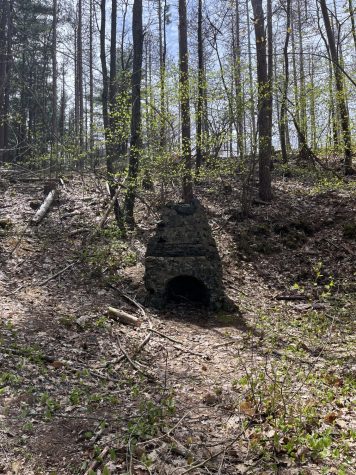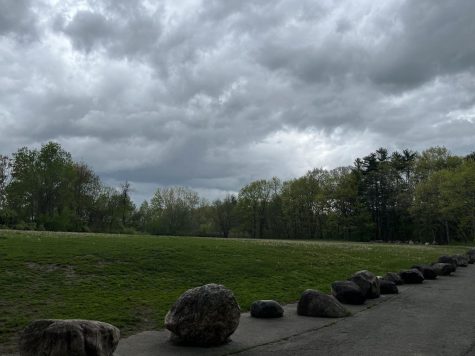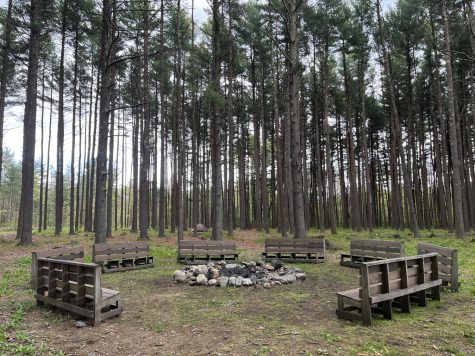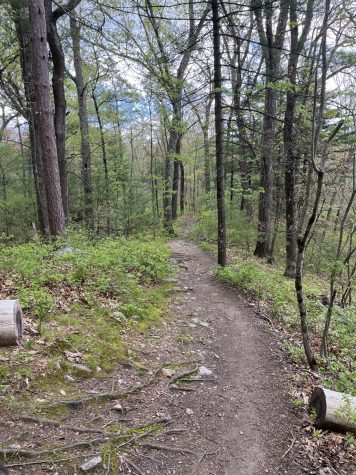A Walk In The Forest
The Reading Town Forest On An Early Spring Day
May 17, 2022
On the flattened side path, the forest canopy briefly opens up, allowing the sunlight to bounce off the steep banked hill on one side. Further down the path, the hill gives way to a small alcove, revealing a hidden treasure of the forest’s past: A broken-down stone chimney.
The chimney — seemingly forgotten, except by the seasonal weather that picks away at the hearth’s stone bricks — is as artificial as the Town Forest itself. According to the Town of Reading, the forest was established in the 1930s when 100,000 trees were planted in the area. In some parts of the forest, the trees are still clearly organized in rows, a clue to the forest’s true origins. Despite these facts, in an ever-evolving community such as Reading, the Town Forest actually resembles the natural look of Reading’s past far more than anywhere else in town. As such, the Town Forest remains as one of Reading’s last refuges for local nature-lovers, and a vital part of the community to many.

The Reading Town Forest, according to the Forest’s Stewardship and Management Plan, is a 322 acre plot of land bordered by the Ipswich River to the north, and the Wilmington town line to the west. To many members of the Reading community, however, it is more. A multitude of paths, some expansive and some thin, connect throughout the forest’s interior, providing visitors with ample routes to walk on and explore. On an early spring day – marked by the small green seedlings germinating along each path – people of all different purposes can be found enjoying nature’s excellence.
Dogs Unleashed
A long dirt road stretches from Grove Street, past the mounds of dirt and leaves making up the town compost, and down to the Town Forest’s entrance — a contained meadow with brick management buildings fenced in on the left. On the right, a tar path curves along the meadow into the forest’s true entrance. Alongside the path by the entrance, a woman can be seen tossing an orange tennis ball across the meadow. Following each throw is Levi, a small 3-year-old dog with a strong aptitude towards the game of fetch. Between throws, the woman turns around and peers down toward the pond adjacent to the tar path. Somewhere around there, her other dog, 10-year-old Malcolm, is going for a swim.

Levi and Malcolm’s caretaker is Kindyll, a frequent visitor of the town forest. According to Kindyll, she visits the town forest every day with her two dogs. As for why she enjoys the forest so much, Kindyll commented, “Our main reason for why we love to come is because it’s dog friendly, and our dogs love to run around.” Kindyll also mentioned the forest’s pleasant community, especially when considering the forest’s significance. “[The forest] is a nice place for the community to come and interact with each other and have a nice solo walk in the woods.”
Shoes Untied
A walk further into the Town Forest reveals a lot more openness than one might expect. In many areas, clean-cut tree trunks are evidence of past logging. In one spot, multiple paths converge into a great open space. Towards the middle of the opening sits a campfire pit, surrounded by benches occasionally occupied by cubs scouts on their many expeditions into the forest.
In this place where many paths meet, a man is kneeled on one knee, tying his shoes. The man’s blue, athletic sweatshirt, suggests that he may be out for a run. When approached, the man, who’s name is David, reveals that he is, indeed, looking to exercise. David, who says he visits the forest about every week and a half, has some practical and some sentimental reasons for doing so.

“I get exercise here,” David claimed, “and my son was a scout, so I have good memories of camping in here.” David calls the Town Forest a “key asset” to the town of Reading. He elaborated: “[The Town Forest] is a large open space, which we don’t have a lot of in the town, so it’s a good place for recreation. And, everyone I know in the town spends some time here at least.” After shaking my hand with his sweaty palm, David picked up his knees, swung his arms, and began to jog away, becoming just another person enjoying the sunshine beaming through the hole in the forest’s canopy above.
Wildlife Unobserved
In addition to the Town Forest’s wide main paths, there are many side paths that splinter into the depths of the forest. These paths snake up and down hills, traverse lively ponds, and are riddled with rocks of all shapes and sizes. From one of these paths emerges a middle-aged couple — the man wears a fuzzy black-and-gold Bruins sweatshirt, while the woman wears a shiny white down jacket. In the woman’s hand is a leash, keeping their white, puffy dog under control by its bright pink collar.

The couple, John and Laurie, seem at peace while walking their dog along the bumpy path. According to Laurie, they visit the Town Forest four to five times a week. Both John and Laurie have personal reasons as to why they love coming to the forest. For John, it’s simple. “The dog likes it, it’s very pretty, and it’s just good exercise.” Adding on, Laurie commented, “I would say I also love the birds. There’s a lot of wildlife here, so early mornings, I really, really enjoy the number of bird species that are in that swamp area, how beautiful that is. And, you meet a lot of lovely people in the forest, especially with dogs.” Both John and Laurie were adamant on the importance of the forest to Reading’s community. Laurie, in particular, commented on the mental health benefits that the forest provides. “I think [the forest] is really important also to the mental health of the community. I think this is a place where people escape, reconnect with nature, and it’s really important that it be accessible,” Laurie reflected.
Though the faint rumble of Route 93 can be frequently heard in the distance, the chirps of birds and bugs still captivate any visitor of the man-made forest. In a town where hard-work and busy days are the norm, the Town Forest stands out like a stone chimney on a wooded walk.